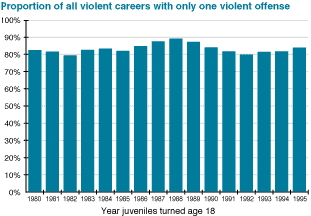| What's Behind the Recent Drop in Juvenile Violent Crime? |
 |
For the first time in nearly 10 years, arrests of juveniles for violent crime declined in 1995.
The FBI's Crime in the United States 1995 series shows that juvenile arrests for violent crime increased annually, and substantially, in the United States between 1988 and 1994. These increases led many to predict a future wave of juvenile violence as the youth population increases into the next century. But in 1995, with a growing juvenile population, violent juvenile crime arrests -- contrary to predictions -- declined. In relative terms, the decline was small (only 3 percent), but the nature of the decline gives hope for the future.
The decline in violent crime arrests in 1995 was driven by decreases in arrests of younger juveniles. Overall, violent crime arrests of juveniles ages 15 to 17 fell by 2% between 1994 and 1995, while arrests of younger juveniles dropped 5%. If delinquency at a younger age is correlated with similar behavior as youth grow older, the lower number of violent crime arrests of younger juveniles in 1995 suggests that their levels of violence at ages 15 to 17 are likely to be below those of today's 15- to 17-year-olds. If so, more declines in juvenile violence should be expected in upcoming years.
The decline in juvenile murders in 1995 was mostly in gun-related
murders by black males.
While juvenile arrests for all violent crime offenses declined, the decline was largest in juvenile arrests for murder, which dropped 14% between 1994 and 1995. Murder arrests had also declined (3%) between 1993 and 1994. If murder arrests can be used as a barometer of future violence, this large decline over the past 2 years also signals that the country may have stemmed the growth of juvenile violence.
Analyses of the FBI's Supplementary Homicide Report data for 1994 and 1995 show that juveniles were involved in 2,300 (or 9.9% of all) murders in 1994 and 1,900 (or 8.9%) in 1995 -- a drop of 400 murders over a 1-year period. An analysis of this reduction in murders involving juveniles indicates that the 400-murder decrease can be broken down in the following overlapping categories: 95% of the decline was in gun-related homicides, 61% in homicides of acquaintances, 96% in homicides committed by males, and 80% in murders committed by black juveniles. Therefore, the large reduction in murders by juveniles between 1994 and 1995 was in gun-related homicides by black males.
|
Five out of six youth referred to juvenile court for a violent offense had no subsequent violent offense referrals -- a pattern that changed little from 1980 through 1995.

Note: This study of 151,000 court-involved youth who turned 18 years of age between 1980 and 1995 found that 8% had at least one violent offense referral in their court careers.
Source: Snyder, H.N. 1997. The Prevalence of Serious, Violent, and Chronic Juvenile Offenders in a Delinquent Population. Pittsburgh, PA: National Center for Juvenile Justice.
|
|
For More Information
Interested readers may obtain a copy of Crime in the United States 1995 by contacting the U.S. Government Printing Office or its local bookstore.
With funds from OJJDP, the National Center for Juvenile Justice (NCJJ) has prepared a user-friendly software package that presents annual juvenile and adult arrest statistics for every county and State in the United States for the past 5 years. Easy Access to FBI Arrest Statistics: 1991-1995 (and two other data sets in the series) can be downloaded from the Highlights section of OJJDP's home page. Copies also can be obtained by calling NCJJ at 412-227-6950 or by writing to the National Center for Juvenile Justice, 710 Fifth Avenue, Third Floor, Pittsburgh, PA 15219-3000.
|
This section was written by Howard N. Snyder, Project Director of the Juvenile Justice Statistics and Systems Development Program of NCJJ. |
|

